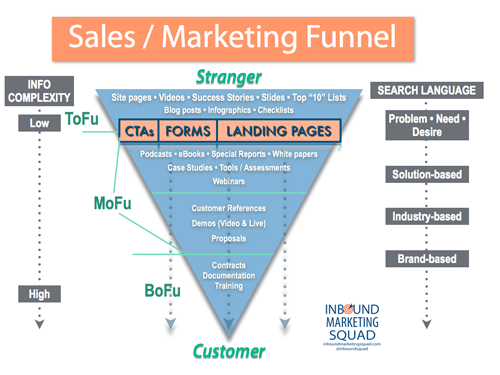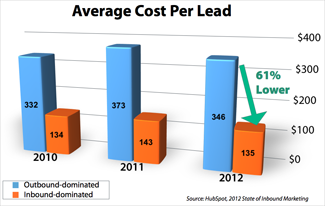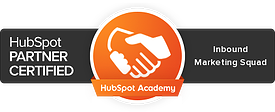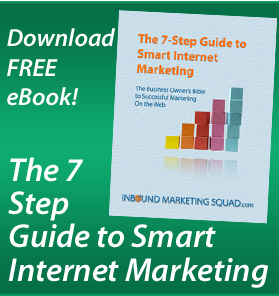One of the most effective ways your business can increase sales is to create and follow a disciplined sales and marketing process.
Your internet marketing funnel is the framework on which this process is built. It should show each stage of the decision making process a potential customer goes through and what information you'll offer and actions you'll take at each of those stages. Typically, a marketing funnel (also called a sales funnel) consists of 3 main stages: the top, the middle and the bottom.
At the top are all the people who have somehow found your website—through search engines, from articles or blog posts they've read, from a friend's suggestion, from a tweet,"like" or "share" they've received, an email they got, among many other sources.
In the middle are those people who have filled out a form on your site and shared their email address (and possibly other data), in exchange for more (detailed) information they downloaded from your site, or a video they watched, or a webinar you gave, etc.
At the bottom are those people who have engaged a great deal with your site and have shown an extremely high level of interest by lots of visits, lots of forms filled out. Once they meet specific criteria that you set, they're considered primed and ready to make their buying decision. That's when these highly qualified leads get handed off to your sales reps to be contacted.
Remember: your ultimate goal is to pull web visitors through each stage of your marketing funnel by converting them into a qualified lead and then continuing to qualify them by nurturing them until they're ready to buy.
Creating an effective marketing funnel requires close collaboration between marketing and sales so as results come through the funnel they're being constantly analyzed and campaigns tweaked (in real time). That way you can optimize your sales funnel and keep honing what works and stop doing what doesn't—increasing efficiency and decreasing costs.
Research from Forrester, eMarketer, Marketing Sherpa and others, shows that companies that define their marketing funnel and consistently follow a sales and marketing process:
- Attract more qualified web traffic
- Qualify leads more quickly
- Convert more sales faster
- Reduce lead acquisition costs
- Increase their revenue
Inbound Marketing + Your Marketing Funnel = Dramatic Results, Faster, Cheaper
With social media on the rise, any company's inbound marketing plan that doesn't include using social media wisely and doing it well, is a company that isn't going to see much in the way of results. Customers today want total control over their buying process. That translates into leveraging permission-based marketing such as search engine marketing, blogs and social media (inbound), instead of more traditional marketing like advertising and direct mail (outbound).
 HubSpot's Science of Social Media Report shows that more than 60% of US adults research online before they buy. They rely on search engines, blogs and online news sites for information. But they rely on social media and online forums for advice. Ignoring social media is the same as sticking your head in the sand.
HubSpot's Science of Social Media Report shows that more than 60% of US adults research online before they buy. They rely on search engines, blogs and online news sites for information. But they rely on social media and online forums for advice. Ignoring social media is the same as sticking your head in the sand.
We don't recommend getting a Twitter account and broadcasting your special offers and discounts in a frenzy. That doesn't work either. Social media needs to be strategically integrated into your overall inbound marketing plan. And inbound marketing, when linked to a defined marketing funnel, has been shown to reduce lead acquisition costs by 61% or more!
If you're new to inbound marketing, we recommend doing your homework and learning more. Here are some other posts you might find useful:
- What' s A Marketing Funnel? What's A Sales Funnel
- How to Optimize Your Marketing Funnel, Part 1
- Optimizing Your Marketing Funnel, Part 2
Creating and managing an inbound marketing plan can sometimes feel overwhelming. It's got a lot of moving parts, making it feel chaotic — keyword strategies and SEO, content creation and curation, lead nurturing, email campaigns, landing pages, calls-to-action, social media publishing and relationship development—not to mention the tracking, measurement and analysis of your results, while keeping an eye on the competition.
Which is why smart companies use software tools such as HubSpot, Nimble, Eloqua, Marketo, Salesforce, Highrise, Google Analytics, Omniture, Coremetrics, etc. to help everything work seamlessly and keep you a step ahead of everyone else.








